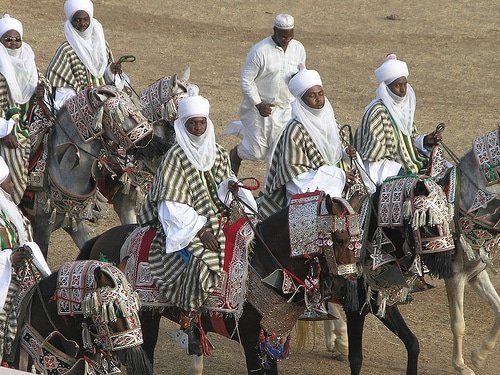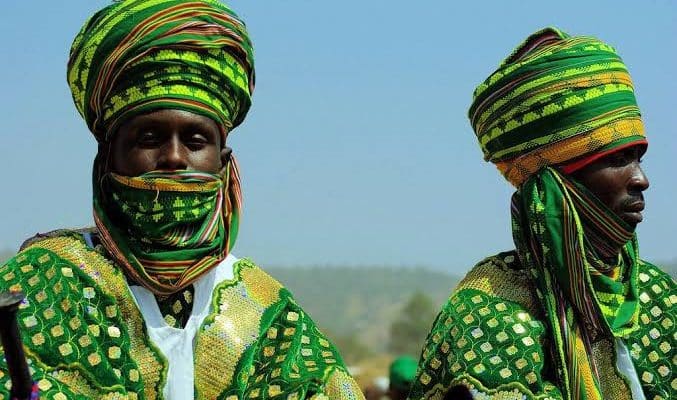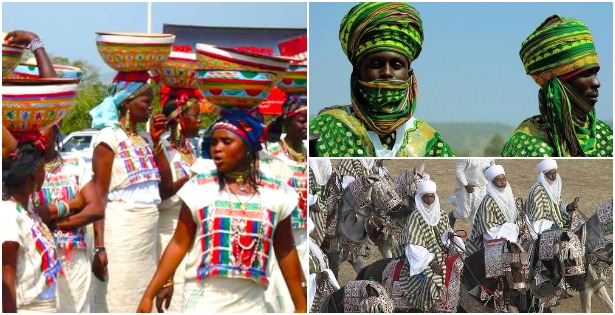The Hausa people are one of the biggest ethnic groups in West Africa, with a population of about 30 million.
They are a diversely culturally oriented people who only share common, homogeneous ideas and practises with other members of their own ethnicity.
Here is all the information you require regarding their diversity.
READ ALSO: Meet the Bodi tribe where men compete to be crowned “fat man of the year”
The Hausa people are mostly found in northern Nigeria and the neighbouring south-eastern Niger.
Additionally, they are found in Cameroon, Ghana, Chad, Togo, Senegal, Côte d’Ivoire, Sudan, and Gabon, among other nations.
History
The Hausa people established the Hausa states, commonly referred to as the Hausaland, which are separate political units that are located between the River Niger and Lake Chad.
Up to the middle of the fourteenth century, it existed as a political unit without a central authority. Regardless of where they were, they shared a language, set of laws, and traditions.
The Hausa people were experts in blacksmithing, agriculture, salt mining, fishing, and hunting.
A major trading hub for ivory, gold, slave trade, salt, textiles, leather, and grains, Kano in northern Nigeria, had risen to prominence by the 1500s.
They were seen by the other towns as loose partnerships because they lacked military prowess and a central governing authority, which made them vulnerable to outside dominance.
Prior to being subdued by a renowned Islamic scholar named Usman dan Fodio in a Holy Jihad (war) that took place between 1804 and 1815 and established the Sokoto Caliphate, all the states were independent.
After the British overthrew the caliphate and disbanded it in 1903 and renamed the region Northern Nigeria.

Popular myth of the origin of Hausa people
The fabled ancestor of the Hausa people, Bayajidda, is claimed to have gone from Baghdad to the Kanem-Bornu Empire in the ninth or tenth century and married a princess there.
Bayajidda was compelled to leave his house, leaving his wife and their young child behind, due to his father-in-law’s inability to reconcile their disputes.
After a very long and tiring trek, he eventually arrived in a place called Daura and asked an elderly woman for water.
The woman told him she didn’t have any water and couldn’t get any at the community well because a snake was terrorizing the locals and only letting them get water once a week, according to legend.
Furious, Bayajidda dashed to the well where he confronted the snake in combat and killed it.
He received the Queen of Daura in marriage as payment, and she gave birth to a son he named Bawo.
Biram’s founding father, Bawo, had six sons who went on to govern over neighbouring Hausa city-states.
The Hausa bakwai (Hausa seven) states are these.
Culture
Despite British colonialism, the Hausa people have preserved their own cultural practises over time.
They still adhere to their traditional ways of life today because their political and religious leaders did not compromise the values they were familiar with.

Religion
Numerous Hausa people are Muslims who adhere to Islamic law based on the teachings of the prophet Muhammad and the guidelines of the Qur’an.
It is alleged that traders from North Africa, Mali, Borneo, and Guinea introduced the religion to them during their trading interactions, and they swiftly adapted it.
Muslims aim to undertake the journey to the holy city of Mecca and engage in five times daily prayer and fasting.
However, there is a group of Hausas known as the Maguzaya who do not follow Islam but are members of a cult that reveres nature spirits called bori or iskoki.
Marriage
A Hausa man goes to ask her parents for his daughter’s hand after meeting the woman he wants to marry.
The bride’s family then conducts an investigation to decide if the man is appropriate for their daughter.
He is permitted to see her for a short period of time if her family approves, but there cannot be any wooing or physical contact before the wedding.
The groom sends his family to the bride’s family for a “Gaisuwa,” or ceremonial introduction.
The bride’s family expects the groom to pay a bride price in addition to giving the bride dowry, or sadaki. A wedding date is then set, followed by a reception that is acceptable to both parties.
READ ALSO: The painful rite of passage into manhood of the Sateré-Mawé Tribe of Brazil
Finger amputation ritual of the Dani Tribe
Meanwhile, the loss of a loved one can be traumatising and result in emotional anguish as well as physical as in the finger amputation ritual of the Dani tribe.
Some cultures consider this outward manifestation of emotional suffering to be crucial to the grieving process.
If she loses a child or member of her family, a woman will cut off the top of her finger.





